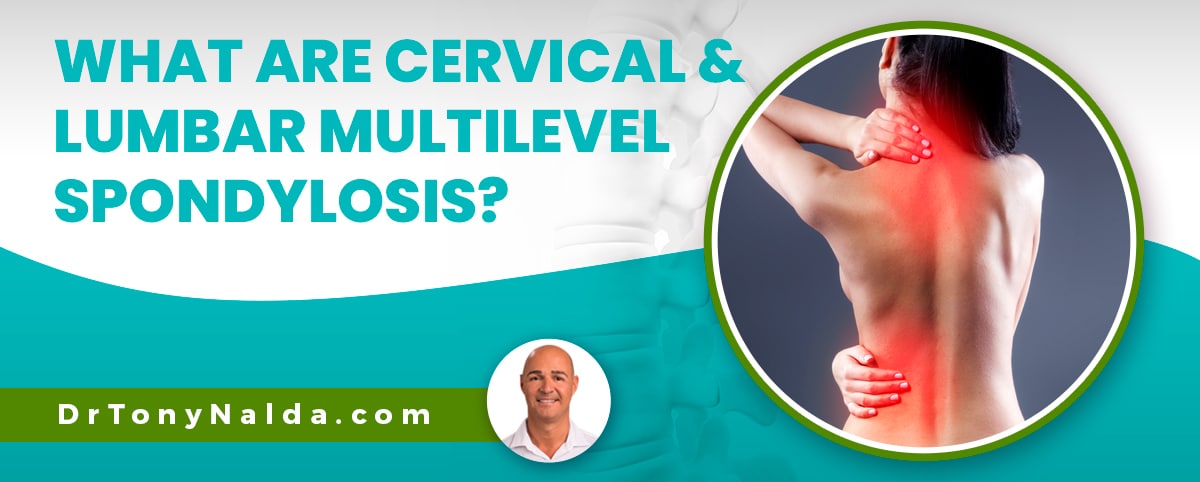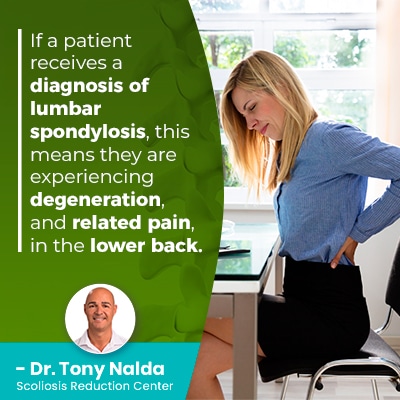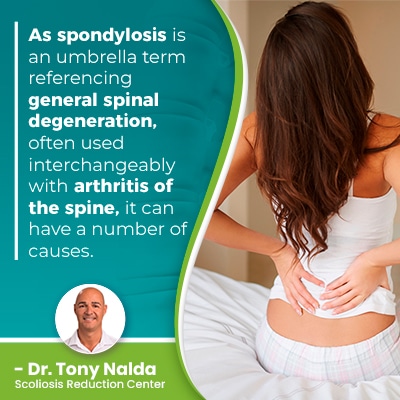What Are Cervical & Lumbar Multilevel Spondylosis?

The spine is a complex structure and like the rest of the body, is subject to the effects of degeneration over time. When the spine is experiencing deterioration, its stability and function can be disrupted. Spondylosis refers to pain related to spinal degeneration; continue reading to learn more about cervical and lumbar multilevel spondylosis and its causes.
Spondylosis is not a condition itself, but is a term referencing general spinal degeneration that causes symptoms like back, nerve, and muscle pain. So while spondylosis refers to symptoms of back pain and discomfort related to spinal degeneration, it doesn’t indicate its location or cause.
Before getting to the specifics of spondylosis, let’s first talk generally about spinal anatomy because it’s key to understanding spinal degeneration.
Table of Contents
Anatomy of the Spine
 In a healthy spine, its vertebrae (bones of the spine) are stacked on top of one another in a straight and neutral alignment and are separated by intervertebral discs.
In a healthy spine, its vertebrae (bones of the spine) are stacked on top of one another in a straight and neutral alignment and are separated by intervertebral discs.
Most often, it’s the spine’s intervertebral discs that are the first spinal structures to show the effects of deterioration.
The discs consist of two main structures: a soft gel-like interior known as the nucleus and a tough durable outer layer called the annulus.
The discs of the spine perform many important roles: providing cushioning between adjacent vertebrae to prevent friction during movement, giving the spine structure (adjacent vertebrae attach to the disc in between), working together to facilitate spinal flexibility and range of motion, and acting as the spine’s shock absorbers.
The main challenge with any type of disc issues is due to the discs being the largest structures inside the body without their own vascular supply; this means there is no direct path into and out of the spinal discs through which nutrients, needed for disc restoration and healing, can pass.
As you can imagine, if any one of those disc roles is adversely affected, it can affect the entire spine.
There are three main spinal sections: cervical (neck), thoracic (middle/upper back), and lumbar (lower back).
Each spinal section has its own characteristic curvature type and a certain number of vertebral bodies; the cervical spine consists of the spine’s first 7 vertebrae (C1 to C7), thoracic spine is the largest spinal section with 12 vertebral bodies (T1 to T 12), and the lumbar spine consists of 5 (L1 to L5).
So as you see, there are different sections and levels to the spine, and the health of each section is dependent upon its ability to maintain its natural curvature and alignment, and each curve is dependent on the health of the spine’s other curves.
So now that we’ve discussed some basic spinal anatomy and understand that there are different spinal sections with different numbers of vertebral bodies within, let’s move on to the specifics of spinal degeneration and spondylosis.
What is Spondylosis?
While the term spinal column makes it sound as though the spine is one long single structure, it actually consists of many different complex and moving parts.
A healthy spine helps us to stand upright, practice good posture, absorb/distribute mechanical stress incurred during movement, and engage in flexible movement.
In addition, the spine works in tandem with the brain to form the body’s central nervous system (CNS) so is key to facilitating brain-body communication; the spine also helps protect important organs.
So the spine is involved in the function of virtually every working system within the body, which is why spinal conditions can become so serious, particularly if left untreated, and produce such a wide range of effects felt throughout the body.
As such a complex and important structure, the spine is vulnerable to developing a number of conditions and issues that affect its overall health and function.
Spondylosis is a term, not a clinical diagnosis, that refers to pain and general spinal degeneration, but the cause of the pain and degeneration could be a number of sources; the term also doesn’t indicate where along the spine the degeneration is affecting the most.
In many cases of spondylosis, a defect in the pars interarticularis, a small piece of bone that attaches the facet joints at the back of the spine, is to blame, and intervertebral disc deterioration is another common cause.
Cervical Spondylosis
While every section of the spine can develop spondylosis, it’s most common in the cervical and lumbar sections, so if a person is diagnosed with cervical spondylosis, they are experiencing spinal degeneration, and related symptoms, in the neck.
The cervical spine is particularly vulnerable to a number of spinal conditions/issues as it has to support the weight of the head and facilitate the neck’s ability to turn side to side and move up and down.
Cervical lordosis refers to the natural inward curve of the neck spine, which, when disrupted, can lead to various symptoms and may require corrective measures and it is also often connected to cervical spondylosis.
Defined as degenerative changes in the spine, cervical and lumbar multilevel spondylosis, involves spondylotic changes in the cervical spine, sacral spondylosis, and multilevel discogenic disease, which can affect the nerve roots and spinal canal, causing chronic neck pain and neck pain; a physical therapist can help relieve pain associated with these conditions, including spondylosis in the thoracolumbar and lumbosacral regions.
Cervical and lumbar multilevel spondylosis, ranging from mild to moderate stages of spinal osteoarthritis, can manifest as conditions like mild multilevel cervical spondylosis or mild lumbar spondylosis, involving disc degeneration and potentially requiring spinal surgery, particularly when moderate spondylosis affects areas like the thoracic spine, leading to spinal stenosis and affecting the spinal cord.
Cervical and lumbar multilevel spondylosis encompass various spinal disorders such as mild lumbar spondylosis, which refers to the degenerative changes in the lower spine, and lumbosacral spondylosis, often causing leg pain, while understanding the difference between spondylosis and spondylitis, including conditions like ankylosing spondylitis and discogenic spondylosis, and exploring treatments with nonsteroidal anti-inflammatory drugs for symptoms like bone spurs and mild anterior spondylosis, is crucial for managing developing spondylitis.
Cervical and lumbar multilevel spondylosis involve degenerative changes in the spine, potentially including reversing degenerative disc disease, and may coincide with conditions like levoconvex scoliosis, retrolisthesis or reversal of cervical lordosis, necessitating comprehensive management strategies.
Lumbar Spondylosis
If a patient receives a diagnosis of lumbar spondylosis, this means they are experiencing degeneration, and related pain, in the lower back.
The lower back is the most prone to problems, and it’s said that everyone will, at some point, experience lower back pain; this is because the lumbar spine has to support the weight of the entire spine above, as well as the entire trunk.
In addition, the vertebrae and discs of the lower back feel the effects of bending, twisting, and lifting, so are particularly vulnerable to natural age-related spinal degeneration.
Multilevel Spondylosis
As mentioned, there are three main sections to the spine, and while cervical and lumbar sections are the most commonly affected by spondylosis, what happens if spinal degeneration isn’t just isolated to one spinal section?
Multilevel spondylosis tends to involve more vertebrae as the degeneration extends beyond one spinal section.
Multilevel spondylosis can also refer to multiple vertebrae being affected within one section, so a diagnosis of multilevel spondylosis means more than one spinal section is involved and/or multiple vertebral bodies within one spinal section are affected.
Multilevel spondylosis is a more severe form quite simply because it means a larger portion of the spine is experiencing degenerative changes.
Common Causes of Spondylosis
 As spondylosis is an umbrella term referencing general spinal degeneration, often used interchangeably with arthritis of the spine, it can have a number of causes.
As spondylosis is an umbrella term referencing general spinal degeneration, often used interchangeably with arthritis of the spine, it can have a number of causes.
There is a certain amount of spinal degeneration to be expected with age, and other factors such as the cumulative effect of negative lifestyle choices can increase those rates; carrying excess weight, leading a sedentary lifestyle, chronic poor posture, and repeatedly lifting heavy objects incorrectly can increase general spinal degeneration.
As mentioned, it’s commonly the spine’s intervertebral discs that are the first spinal structures to experience deterioration, so disc desiccation, often part of degenerative disc disease, can cause spondylosis as a disc can become dehydrated, change shape, and affect surrounding vertebrae.
In addition, changes to a disc can cause nerve involvement by introducing uneven pressure to the spine and its surrounding nerves and muscles.
In addition, the presence of osteoarthritis and/or osteoporosis can also cause spondylosis as they increase spinal degeneration by weakening the cartilage, joints and bones of the spine.
As spondylosis often involves degeneration of the intervertebral discs and/or facet joints, if left untreated, spondylosis can progress to spondylolysis: vertebral defect caused by the separation of the pars interarticularis.
Again, spondylosis refers to pain and discomfort (more common in adults) due to spinal degeneration and can involve localized back pain and/or radicular pain felt throughout the body, as well as related muscle pain.
Cervical and lumbar multilevel spondylosis, conditions characterized by degenerative changes in the spine, can often be accompanied by complications such as levoscoliosis of the lumbar spine, a topic extensively covered on Dr. Tony Nalda's blog.
Conclusion
When it comes to spinal health and function, being proactive is key. Once spinal degeneration has started, it can be difficult to reverse or slow down, particularly once it starts to cause functional deficits.
As degenerative effects are likely going to increase with age, efforts need to be made to cultivate a spine-friendly lifestyle to preserve spinal function and prevent and/or slow further spinal deterioration for as long as possible
Here at the Scoliosis Reduction Center, I respond to my spondylosis patients with proactive treatment that’s driven by causation.
Once I determine what’s caused the pain and discomfort, whether a disc, facet joint issue, or the presence of another spinal condition, that’s what shapes the crafting of customized and effective treatment plans.
As spondylosis is caused by wear and tear on the spine and its surroundings that develop over time, the process of addressing it and managing symptoms can be lengthy, but being proactive means working towards preventing further deterioration, preserving disc health, and improving the overall health and function of the spine.
Through chiropractic care, physical therapy, and rehabilitation, cervical & lumbar multilevel spondylosis can be managed effectively so improvements can be made to quality of life.
Regardless of age, the right time to start spondylosis treatment is always now; when it comes to spinal degeneration, efforts need to be made to prevent further damage, preserve as much natural function as possible, and improve the spine’s biomechanics.
The only way to achieve long-term sustainable pain management with spondylosis, and any spinal condition for that matter, is by addressing its underlying cause; this is the difference between treating pain as a symptom, or the condition causing it.
Dr. Tony Nalda
DOCTOR OF CHIROPRACTIC
After receiving an undergraduate degree in psychology and his Doctorate of Chiropractic from Life University, Dr. Nalda settled in Celebration, Florida and proceeded to build one of Central Florida’s most successful chiropractic clinics.
His experience with patients suffering from scoliosis, and the confusion and frustration they faced, led him to seek a specialty in scoliosis care. In 2006 he completed his Intensive Care Certification from CLEAR Institute, a leading scoliosis educational and certification center.
About Dr. Tony Nalda
 Ready to explore scoliosis treatment? Contact Us Now
Ready to explore scoliosis treatment? Contact Us Now





